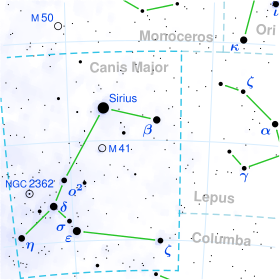| Observation data Epoch J2000.0 Equinox J2000.0 (ICRS) | |
|---|---|
| Constellation | Canis Major |
| Right ascension | 06h 54m 13.04410s[1] |
| Declination | −23° 55′ 42.0150″[1] |
| Apparent magnitude (V) | 6.91[2] 6.71 to 6.95[3] |
| Characteristics | |
| Spectral type | WN4-s[4] |
| U−B color index | −0.89[2] |
| B−V color index | −0.28[2] |
| Variable type | UGZ?[3] |
| Astrometry | |
| Proper motion (μ) | RA: −4.431±0.057[5] mas/yr Dec.: 2.884±0.092[5] mas/yr |
| Parallax (π) | 0.4119 ± 0.0503 mas[5] |
| Distance | 4,900 ly (1,500[6] pc) |
| Absolute magnitude (MV) | −5.33[4] |
| Orbit[7] | |
| Period (P) | 3.63 d |
| Semi-major axis (a) | 0.13 au |
| Eccentricity (e) | 0.10 |
| Inclination (i) | 74° |
| Details | |
| WR | |
| Mass | 23[4] M☉ |
| Radius | 3.25[4] R☉ |
| Luminosity (bolometric) | 620,000[4] L☉ |
| Temperature | 89,100[4] K |
| companion | |
| Mass | 1.5[7] M☉ |
| Other designations | |
| Database references | |
| SIMBAD | data |
EZ Canis Majoris (abbreviated to EZ CMa, also designated as WR 6) is binary system in the constellation of Canis Major. The primary is a Wolf-Rayet star and it is one of the ten brightest Wolf-Rayet stars, brighter than apparent magnitude 7.[8]
- ^ a b Van Leeuwen, F. (2007). "Validation of the new Hipparcos reduction". Astronomy and Astrophysics. 474 (2): 653–664. arXiv:0708.1752. Bibcode:2007A&A...474..653V. doi:10.1051/0004-6361:20078357. S2CID 18759600.
- ^ a b c Ducati, J. R. (2002). "VizieR Online Data Catalog: Catalogue of Stellar Photometry in Johnson's 11-color system". CDS/ADC Collection of Electronic Catalogues. 2237: 0. Bibcode:2002yCat.2237....0D.
- ^ a b Samus, N. N.; Durlevich, O. V.; et al. (2009). "VizieR Online Data Catalog: General Catalogue of Variable Stars (Samus+ 2007–2013)". VizieR On-line Data Catalog: B/GCVS. Originally Published in: 2009yCat....102025S. 1: 02025. Bibcode:2009yCat....102025S.
- ^ a b c d e f Sota, A.; Maíz Apellániz, J.; Morrell, N. I.; Barbá, R. H.; Walborn, N. R.; Gamen, R. C.; Arias, J. I.; Alfaro, E. J.; Oskinova, L. M. (2019). "The Galactic WN stars revisited. Impact of Gaia distances on fundamental stellar parameters". Astronomy & Astrophysics. A57: 625. arXiv:1904.04687. Bibcode:2019A&A...625A..57H. doi:10.1051/0004-6361/201834850. S2CID 104292503.
- ^ a b c Brown, A. G. A.; et al. (Gaia collaboration) (August 2018). "Gaia Data Release 2: Summary of the contents and survey properties". Astronomy & Astrophysics. 616. A1. arXiv:1804.09365. Bibcode:2018A&A...616A...1G. doi:10.1051/0004-6361/201833051. Gaia DR2 record for this source at VizieR.
- ^ Toalá, J. A.; Guerrero, M. A.; Ramos-Larios, G.; Guzmán, V. (2015). "WISE morphological study of Wolf-Rayet nebulae". Astronomy & Astrophysics. 578: A66. arXiv:1503.06878. Bibcode:2015A&A...578A..66T. doi:10.1051/0004-6361/201525706. ISSN 0004-6361. S2CID 55776698.
- ^ a b Schmutz, W.; Koenigsberger, G. (2019). "Long uninterrupted photometric observations of the Wolf-Rayet star EZ CMa by the Toronto BRITE satellite reveal a very fast apsidal motion". Astronomy & Astrophysics. 624: L3. arXiv:1903.09501. Bibcode:2019A&A...624L...3S. doi:10.1051/0004-6361/201935094. S2CID 85459362.
- ^ Van Der Hucht, Karel A. (2001). "The VIIth catalogue of galactic Wolf–Rayet stars". New Astronomy Reviews. 45 (3): 135–232. Bibcode:2001NewAR..45..135V. doi:10.1016/S1387-6473(00)00112-3.
